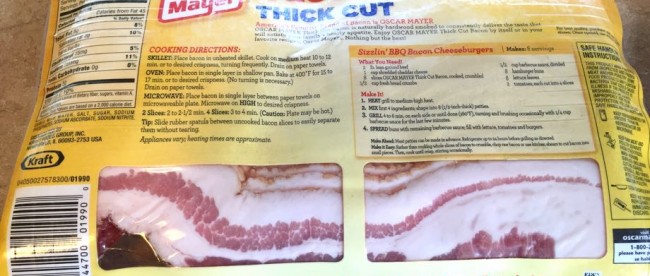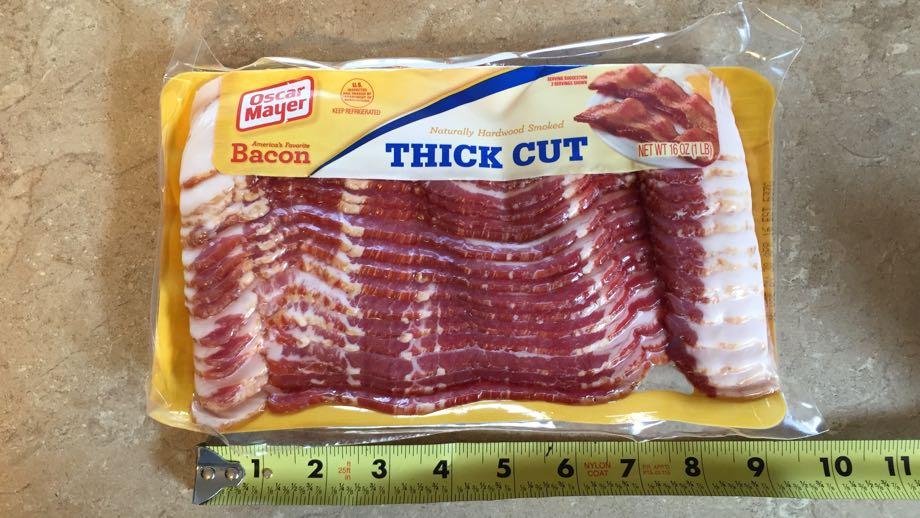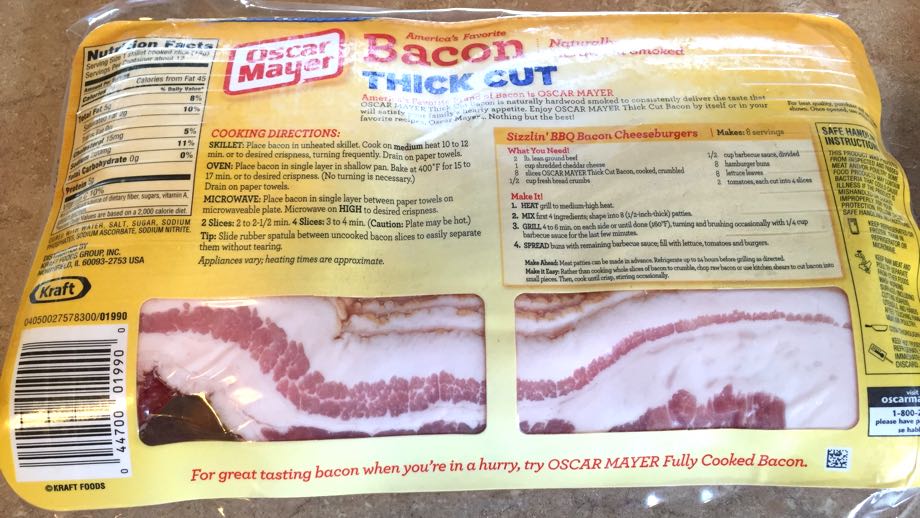The Window of Bacon Fat


Pictured above is a one-pound pack of Oscar Mayer thick cut bacon — and a tape measure. The tape measure is there because the picture above (and the one below) comes from an article rating the “top grocery store bacon brands” on a website known as “Bacon Scouts” — for some reason when you need to rate bacon, you need to measure it. But that’s not important, and neither is the tape measure, at least not for our purposes. What’s important is how the meat looks. As Bacon Scouts points out, “the way it is layered emphasizes the meaty side of the bacon. The strips are cut in a way so that one edge is the meat. This edge is then angled and displayed in a way to make the consumer think they are getting a great package of thick, meaty bacon.”
It’s a lie.
The proof? Just flip the package over.

That window shows the true nature of the meat. To continue with Bacon Scouts, “flipping over the bacon package will give you a clear view of an entire slice (if not the whole package) of bacon revealing how fatty it really is. It’s such a disappointment to have most of the bacon be fat.”
Why the lie? What’s the point of setting up a fake display on the front, only to give away the truth to anyone who checks the other side?
It turns out, the back window is there because it’s the law — and has been since 1974, shortly after bacon sellers came up with the idea to stack bacon to make it seem less fatty. Claiming that the front of the package arrangement was akin to deceptive advertising, the government promulgated a regulation laser-focused on this problem. Here’s what they came up with — it’s section 317.8(5)(ii) of title 9 of the Code of Federal Regulations if you want to look it up:
(ii) Packages for sliced bacon that have a transparent opening shall be designed to expose, for viewing, the cut surface of a representative slice. Packages for sliced bacon which meet the following specifications will be accepted as meeting the requirements of this subparagraph provided the enclosed bacon is positioned so that the cut surface of the representative slice can be visually examined:
(a) For shingle-packed sliced bacon, the transparent window shall be designed to reveal at least 70 percent of the length (longest dimension) of the representative slice, and this window shall be at least 1 1/2 inches wide. The transparent window shall be located not more than five-eighths inch from the top or bottom edge of a 1-pound or smaller package and not more than three-fourths inch from either the top or bottom edge of a package larger than 1 pound.
(b) For stack-packed sliced bacon, the transparent window shall be designed to reveal at least 70 percent of the length (longest dimension) of the representative slice and be at least 1 1/2 inches wide.
The bacon pictured above is shingle-packed sliced bacon, so subsection (a) applies. The regulation clearly spells out that a “representative slice” be made visible through a “transparent window.” And while the regulation also dictates, in part, where that window has to be (e.g. “not more than five-eighths inch from the top or bottom edge”), it omits a critical detail — it doesn’t say which side of the package it should be on.
As a result, we get the mullet of meat — business in the front, party in the back. As Bloomberg concludes, “It’s hard to think of another package that engages in such a clever sleight of hand on the front and then gives away the game” on the other side.
Bonus fact: In 2009, Newcastle University released the findings of a study which came with this attention-grabbing headline: bacon sandwiches reduce the effect of hangovers. But don’t get too excited. As the Telegraph explains, any meat-based sandwich will do.
From the Archives: Bacon of the Sea: When pigs swim.
Related: Bacon stickers.
